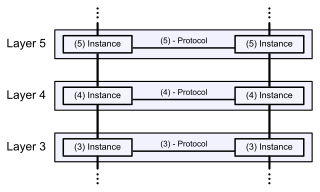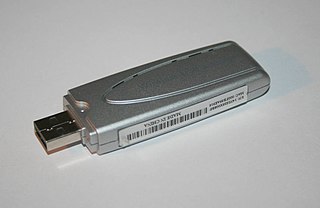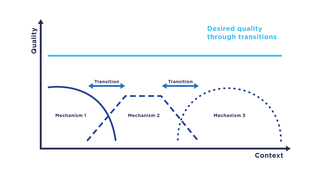The Internet protocol suite, commonly known as TCP/IP, is a framework for organizing the set of communication protocols used in the Internet and similar computer networks according to functional criteria. The foundational protocols in the suite are the Transmission Control Protocol (TCP), the User Datagram Protocol (UDP), and the Internet Protocol (IP). Early versions of this networking model were known as the Department of Defense (DoD) model because the research and development were funded by the United States Department of Defense through DARPA.

The Open Systems Interconnection (OSI) model is a reference model from the International Organization for Standardization (ISO) that "provides a common basis for the coordination of standards development for the purpose of systems interconnection." In the OSI reference model, the communications between systems are split into seven different abstraction layers: Physical, Data Link, Network, Transport, Session, Presentation, and Application.
In the seven-layer OSI model of computer networking, the physical layer or layer 1 is the first and lowest layer: the layer most closely associated with the physical connection between devices. The physical layer provides an electrical, mechanical, and procedural interface to the transmission medium. The shapes and properties of the electrical connectors, the frequencies to transmit on, the line code to use and similar low-level parameters, are specified by the physical layer.
The data link layer, or layer 2, is the second layer of the seven-layer OSI model of computer networking. This layer is the protocol layer that transfers data between nodes on a network segment across the physical layer. The data link layer provides the functional and procedural means to transfer data between network entities and may also provide the means to detect and possibly correct errors that can occur in the physical layer.
IEEE 802.1 is a working group of the IEEE 802 project of the IEEE Standards Association.

In IEEE 802 LAN/MAN standards, the medium access control (MAC), also called media access control, is the layer that controls the hardware responsible for interaction with the wired or wireless transmission medium. The MAC sublayer and the logical link control (LLC) sublayer together make up the data link layer. The LLC provides flow control and multiplexing for the logical link, while the MAC provides flow control and multiplexing for the transmission medium.

The 3rd Generation Partnership Project (3GPP) is an umbrella term for a number of standards organizations which develop protocols for mobile telecommunications. Its best known work is the development and maintenance of:

IEEE 802.20 or Mobile Broadband Wireless Access (MBWA) was a specification by the standard association of the Institute of Electrical and Electronics Engineers (IEEE) for mobile broadband networks. The main standard was published in 2008. MBWA is no longer being actively developed.

A wireless network interface controller (WNIC) is a network interface controller which connects to a wireless network, such as Wi-Fi, Bluetooth, or LTE (4G) or 5G rather than a wired network, such as an Ethernet network. A WNIC, just like other NICs, works on the layers 1 and 2 of the OSI model and uses an antenna to communicate via radio waves.
IEEE 802.11p is an approved amendment to the IEEE 802.11 standard to add wireless access in vehicular environments (WAVE), a vehicular communication system. It defines enhancements to 802.11 required to support intelligent transportation systems (ITS) applications. This includes data exchange between high-speed vehicles and between the vehicles and the roadside infrastructure, so called vehicle-to-everything (V2X) communication, in the licensed ITS band of 5.9 GHz (5.85–5.925 GHz). IEEE 1609 is a higher layer standard based on the IEEE 802.11p. It is also the basis of a European standard for vehicular communication known as ETSI ITS-G5.

Profinet is an industry technical standard for data communication over Industrial Ethernet, designed for collecting data from, and controlling equipment in industrial systems, with a particular strength in delivering data under tight time constraints. The standard is maintained and supported by Profibus and Profinet International, an umbrella organization headquartered in Karlsruhe, Germany.
Vehicular ad hoc networks (VANETs) are created by applying the principles of mobile ad hoc networks (MANETs) – the spontaneous creation of a wireless network of mobile devices – to the domain of vehicles. VANETs were first mentioned and introduced in 2001 under "car-to-car ad-hoc mobile communication and networking" applications, where networks can be formed and information can be relayed among cars. It was shown that vehicle-to-vehicle and vehicle-to-roadside communications architectures will co-exist in VANETs to provide road safety, navigation, and other roadside services. VANETs are a key part of the intelligent transportation systems (ITS) framework. Sometimes, VANETs are referred as Intelligent Transportation Networks. They are understood as having evolved into a broader "Internet of vehicles". which itself is expected to ultimately evolve into an "Internet of autonomous vehicles".

In telecommunications, 5G is the fifth-generation technology standard for cellular networks, which cellular phone companies began deploying worldwide in 2019, and is the successor to 4G technology that provides connectivity to most current mobile phones.

Vehicle-to-everything (V2X) describes wireless communication between a vehicle and any entity that may affect, or may be affected by, the vehicle. Sometimes called C-V2X, it is a vehicular communication system that is intended to improve road safety and traffic efficiency while reducing pollution and saving energy.

Transition refers to a computer science paradigm in the context of communication systems which describes the change of communication mechanisms, i.e., functions of a communication system, in particular, service and protocol components. In a transition, communication mechanisms within a system are replaced by functionally comparable mechanisms with the aim to ensure the highest possible quality, e.g., as captured by the quality of service.

SMARTY is a mobile telephone flanker brand operated by Three UK. It aims to attract customers primarily looking for cheaper deals than those available direct from Three, by offering a monthly rolling SIM-only service, limited to online-only support. On some plans the operator offers to buy back unused data by means of a bill discount, a practice which is not widespread in the UK but is exhibited elsewhere such as by US carrier Ting.
IEEE 1914.1 is a standard for packet-based fronthaul transport networks developed under IEEE 1914 Next Generation Fronthaul Interface – NGFI (xhaul) Working Group. NGFI (xhaul) working group is sponsored by IEEE Communications Society/Standards Development Board (COM/SDB). IEEE 1914.1 standardizes architecture and requirements for mobile fronthaul network – spanning between cell sites and centralized baseband locations in Centralized, Collaborative, Cloud and Clean Radio Access Network C-RAN.
Packet Forwarding Control Protocol (PFCP) is a 3GPP protocol used on the Sx/N4 interface between the control plane and the user plane function, specified in TS 29.244. It is one of the main protocols introduced in the 5G Next Generation Mobile Core Network, but also used in the 4G/LTE EPC to implement the Control and User Plane Separation (CUPS). PFCP and the associated interfaces seek to formalize the interactions between different types of functional elements used in the Mobile Core Networks as deployed by most operators providing 4G, as well as 5G, services to mobile subscribers. These two types of components are:
- The Control Plane (CP) functional elements, handling mostly signaling procedures
- The User-data Plane (UP) functional elements, handling mostly packet forwarding, based on rules set by the CP elements.
5G network slicing is a network architecture that enables the multiplexing of virtualized and independent logical networks on the same physical network infrastructure. Each network slice is an isolated end-to-end network tailored to fulfill diverse requirements requested by a particular application.









